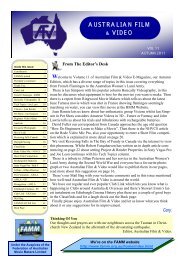Australian film - Federation of Australian Movie Makers
Australian film - Federation of Australian Movie Makers
Australian film - Federation of Australian Movie Makers
You also want an ePaper? Increase the reach of your titles
YUMPU automatically turns print PDFs into web optimized ePapers that Google loves.
One thing we can be pretty sure <strong>of</strong>, is that probably none <strong>of</strong> these media will be around in even twenty or<br />
thirty years. Even if they were, would they be sufficiently reliable to trust with our memories? DVDs<br />
should be, but with them now being churned out like sausages, who can be sure? Hard discs fail, more <strong>of</strong>ten<br />
than many <strong>of</strong> us appreciate. I must have been extremely lucky; as I have never had a disc failure in any<br />
machine I have ever owned or had association with. But I have seen a report from Google that in a survey<br />
<strong>of</strong> 100,000 drives in their organisation world wide, there was a failure rate <strong>of</strong> 8% over three years.<br />
Solid-state memory is a mess. While it is going to be a cool thing for the foreseeable future, there are so<br />
many competing styles, formats and hype from so many incompatible manufacturers that it is going to require<br />
a major shakedown to come up with a format for the long term. Are these cards reliable long term?<br />
Who knows, there has been no long term, yet, to try them. Hard discs, after all, gradually lose their magnetic<br />
impulses over time if they are not frequently refreshed.<br />
The only medium that has any sort <strong>of</strong> a track record is tape. Thirty year old VHS tape can <strong>of</strong>ten still be<br />
played without problems and digital tapes should be better. But, tape is on the way out. An answer is possibly<br />
to re-record the material to the current technology as it advances into the future. That should keep<br />
someone busy! So, what is the answer? I don’t know. We all need some good ideas.<br />
The rise and rise <strong>of</strong> High Def …<br />
A feature movie has recently been completed in Hollywood. So what, you may ask. Well, this one has a<br />
small difference. It’s called “Crank 2: High Voltage” and was shot with five Canon XH-A1 cameras.<br />
That’s right, the same little camera that a number <strong>of</strong> independent movie-makers around town use. Many <strong>of</strong><br />
us chose the camera on price, but our big-time crew chose it because <strong>of</strong> it’s compact size and the quality <strong>of</strong><br />
the lens.<br />
The “style” <strong>of</strong> the movie lent itself to compact, lightweight cameras. The Canons could be mounted on<br />
such things as skate boards and handheld poles (shades <strong>of</strong> Hermann’s pole-cam!) and because <strong>of</strong> their virtually<br />
unlimited configuration capabilities, they could all be precisely matched picture and colour wise.<br />
[Any one who imagines that two cameras <strong>of</strong> the same model from the same manufacturer should produce<br />
pictures that look the same should have seen the results from Alan Scott’s two Sony VX- 5000’s a few<br />
years ago.]<br />
The point <strong>of</strong> this little story is not that “Canon rules”, but that high definition cameras <strong>of</strong> quite modest cost<br />
and complexity have come so far in such a short time. It is only two or three years since pr<strong>of</strong>essional cameramen<br />
were openly sc<strong>of</strong>fing that video would never see the light <strong>of</strong> day commercially. What will the next<br />
two or three years bring?<br />
Neal Reville<br />
WD TV HD Media Player<br />
Reprinted from BVMA May 2009 Scanlines with permission from Neal Reville.<br />
<strong>Australian</strong> <strong>film</strong> & video<br />
Page 11










